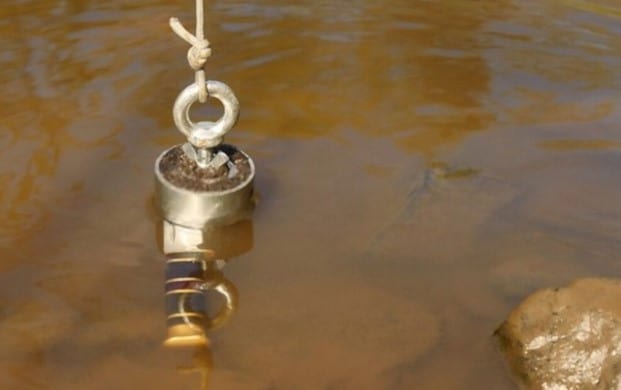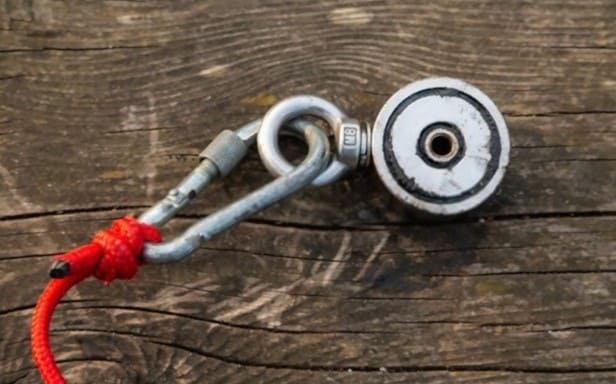Have you ever lost something inside a lake or any other water body? Maybe you are wondering about things that may be buried in your yard, at the bottom of a lake, or at the beach. It may be that you love some adventure and searching for treasures below the sea. Whatever you are looking for, you can search for most buried metallic objects using magnets.

Metal detectors are generally used in searching for metal objects buried in the ground. However, magnets can be used for objects below water. This is often referred to as magnetic fishing. You can learn more about this here.
Quick Navigation
What Is Magnetic Fishing?
Normally, you would need a hook to bait and catch a fish but in magnetic fishing, the prey is different. You do not actually catch fishes but you recover or find lost items using magnets. A lot of people do this as a sport these days for fun. If you are in luck, you may find real treasures such as militaria or coins.
Magnetic fishing is when people use powerful magnets to try and grab ferromagnetic metal objects that are lost or hidden underwater. Imagine your important keys dropping inside a fairly deep water body. Where do you begin to search for it? Using a magnet makes this easier.

The thing is a lot of people do this for fun and sport these days as alluded to earlier rather than looking for something in particular. The hobby can be seen as a combination of treasure hunting and an act of environmentalism. Most people that indulge in this are typically looking forward to finding rare as well as valuable items.
The magnets used are usually powerful enough to extract large debris like guns, bicycles, bombs, safes, tire rims, grenades and many more. The chance that a fisher will retrieve a valuable treasure is slim. However, the highlight of the whole adventure is the surprise you get.
You never know what you will retrieve and this gives it a suspenseful edge. Coupled with this is the fact that the range of objects that can be retrieved is large. The surprise however may not always be pleasing. The environmental benefit to it is that it is a way to remove junk and clean up a body of water.
Equipment Required For Magnetic Fishing

To get involved, you do not need much but it is essential you use the right set of tools. These include:
- A magnet
- A rope, and
- A transport box (This is not necessary but you may need it to transport whatever you retrieve).
You may go along with gloves to help protect your hand when you pull the rope. The fish magnet to be used must be a powerful one. Typically this is neodymium or any other powerful magnet. Never make the mistake of fastening a household magnet to a rope and then throwing it into the water.
The way it works is that a strong magnet is tied to the end of a rope which is about 15 to 30 meters long. This is thrown into the water. If there are any metallic objects, they stick to the magnet and you can pull this out.
To avoid coming into conflict with owners of water bodies, government officials and environmentalists, you should use appropriate magnets. You should also fish only in appropriate locations.
When choosing a magnet, performance is crucial. You cannot use household magnets that are used on memo boards or refrigerators as they cannot pull heavy objects. Neodymium magnets are great for fishing. They may also be referred to as recovery magneten, weigh quite a few kilos and are cheaper to get than metal detectors.
Neodymium is a rare-earth metal and it is one of the strongest metals available on the earth. This material is used for making neodymium magnets and in essence, this makes them strong. These magnets vary in force as well as type but are capable of pulling heavy weights.
A note of warning; do not try to put two of these magnets together else they will shatter. You should also keep the tips below in mind when shopping for a neodymium magnet.
Traction

The higher the traction of the magnet, the better it is but this is only to a certain degree. A pulling force of around 150 kg is typically sufficient. This is because there is no chance of pulling an object that weighs several hundred kilos out of the water if your magnet gets stuck to it. You may need to let your magnet go or dive in to save it.
Size
Most neodymium magnets are between 70 – 100 mm in size. It is better for have a bigger size because the support surface is increased. Although most magnets are round, you can also get square ones.
In addition to the magnet, you require a rope and bear in mind that a normal fishing rope is not useful here. The pull force here is much greater. You must also give consideration to its traction. This must be high enough so you are able to use it to pull without it ripping.
Furthermore, the length must just be sufficient. A length of between 15 and 20 meters is good as it will be difficult to handle if longer or shorter. The diameter of the rope is important. It should not be more than 10mm so it is not heavy and difficult to pull.
The material of the rope is also crucial. Synthetic materials like polypropylene or nylon are some of the best. This is because they do not absorb water neither do they rust especially when they are dry-treated. You can learn more about all of these here: https://fishingbooker.com/blog/magnet-fishing/.
Conclusion
Magnetic fishing is a hobby or fun way of seeking out hidden or buried treasure underneath water. However, to get involved, you need simple but practical tools. Some of the things you will pull out will be heavy. You must therefore use a corresponding set of equipment that is able to do the job. At the same time, these must not be too heavy to retrieve.

